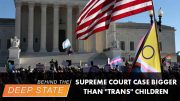
As for the last matter, their latest effort is H.R. 1913, the Local Law Enforcement Hate Crimes Prevention Act, which the House of Representatives passed on April 29 by a vote of 249-175. Known as the “Matthew Shepard Act” in the Senate, the bill would add “sexual orientation” as a protected class in federal hate-crime statutes. In fact, according to the Traditional Values Coalition (TVC), it would include a staggering 30 different sexual orientations. Moreover, Iowa Congressman Steve King stated on the House floor that the bill would also cover 547 types of paraphilia, which is obsession with unusual sexual practices. This would even include pedophilia.
Critics say this is nonsense, that the TVC is basing its assessment on the fourth edition of the Diagnostic and Statistical Manual of Mental Disorders (DSM-IV) and misrepresenting the facts. They say the manual doesn’t actually contain a list of sexual orientations — only sexual and gender identity disorders — which include paraphilias. In other words, the new hate-crime legislation wouldn’t have to protect these perversions because, technically, they’re not designated as “sexual orientations.”
But while these critics do seem to be correct about the terminology, the interpretation is a different matter. The hate-crimes bill fails to define “sexual orientation,” thus leaving much room for mischief. And the legislation’s proponents certainly give us ample cause for alarm. For example, Congressman Alcee Hastings (D-Fla.) said on the House floor, “This bill addresses our resolve to end violence based on prejudice and to guarantee that all Americans regardless of race, color, religion, national origin, gender, sexual orientation, gender identity, or disability or all of these ‘Philias’ and fetishes and ‘isms’ that were put forward need not live in fear because of who they are.” Of course, Hastings’ comments could be explained away as the rambling of an impeached ex-judge, but what Janet Porter at WorldNetDaily.com reports is not so easy to rationalize away. She writes, “Rep. Steve King, R-Iowa, offered this very simple amendment to H.R. 1913 in the House Judiciary Committee: ‘The term sexual orientation as used in this act or any amendments to this act does not include pedophilia.’ It was rejected.” It seems the ghost of Alfred Kinsey roams the halls of Congress.
But, really, the point is that, like so much legislation, the hate-crime bill is so ambiguous (politicians sometimes like this type of legislation because they don’t have to commit to a hard-and-fast position) that it can only end up in one place: the courts. Then our “enlightened” judiciary will determine what the law really means. Yet, as bad as all this is, there is something far more ominous.
Basis of the Laws
It’s a mistake to get bogged down discussing the details of hate-crime laws because the real problem lies in the laws themselves. Why? Because they are an effort at thought control. To illustrate this point, consider a scenario wherein two identical criminal acts are committed. The first is found to have been motivated by a politically correct sin, greed, but the second, well, it’s a different matter. It’s deemed to have been motivated by the new father of all sins, hate. Consequently, while perpetrator one, Mr. Greed, receives only 8 years in prison, Mr. Hate is sent away for a whopping 15 years. Now, if the act when considered alone warranted a mere eight years, what were the extra seven years handed down to Mr. Hate for? Could it be for the ideas expressed through the act?
There is another problem with hate-crime laws. They discriminate not just among different sinful motivations but among different sinners with the same motivation and, by extension, among different victims of it. Steve Chapman writing in the Chicago Tribune treats this and opines:
The logic behind the proposed measure [The Matthew Shepard Act] is hard to follow. Says sponsoring Sen. Ted Kennedy (D-Mass.), “No members of society — none — deserve to be victims of a violent crime because of their race, their religion, their ethnic background, their disability, their gender, their gender identity, or their sexual orientation.” Which raises the question: Who exactly does deserve to be the victim of a violent crime?
I suppose the answer would be the elderly and pregnant women (among other groups), as the Democrats defeated Republican amendments to H.R. 1913 to include them as protected groups.
This brings us to a question: these laws are designed to target prejudice, but are their supporters often motivated by nothing but prejudice themselves? After all, if “hate” really is their concern, why not just administer the extra punishment to any criminal thus motivated? Why this cherry-picking of politically favored groups for protected status? Even more to the point, if eliminating the violence in question really matters to these social engineers, and if hate-crime level punishment is deemed necessary as a deterrent, why not just apply it across-the-board? In other words, if labeling a criminal act a hate crime would give a perpetrator another 10 years up the river, why not simply hand down that punishment for all such acts? Remember, the left often preaches about the importance of consensus-building and compromise. Well, what could be a tidier halfway meeting place? Those who want certain groups protected would get their wish, while people concerned about Big Brother’s thought control would also get theirs. It seems like a win-win situation.
Yet hate-crime law proponents recoil at such suggestions. In their universe, all groups deserve equal protection, but some deserve more equal protection than others. It’s also plain that the real goal here is to send a message, one seeking to stigmatize the left’s newly minted sins. Hate-crime laws aren’t at all about eliminating hate; they’re about eliminating what leftists happen to hate. Leftists feel sympathy for minorities and homosexuals, so they get protection, but not for whites and heterosexuals, so they get projection. This explains the blatant double standards in hate-crime law application.
As an example of this, criminal defense lawyer Robert J. Corry, Jr., in a Denver Post piece entitled “Thought crime a reality,” writes, “When a Colorado gang engaged in an initiation ritual of specifically seeking out a ‘white woman’ to rape, the Boulder prosecutor declined to pursue ‘hate crime’ charges. So the ‘hate crime’ law does not apply equally, instead criminalizing only politically incorrect thoughts directed against politically incorrect victim categories.” And remember that the rationale justifying this now has long-standing precedent. For instance, just think about that tendentious definition of “racism” stating that a black person cannot be “racist” because a prerequisite for this is that a group must wield the power to oppress. Well, in keeping with this, I could very well envision some ambitious social engineer averring that minorities cannot be guilty of hate crimes because they don’t have the power to terrorize a community (maybe I just gave them an idea).
So let’s make no mistake about the message here: because some people matter more than others, hating some racial and ethnic groups is worse than hating others. Yet it’s time for some historical perspective. Eighty years ago, it was a lot worse for a black man to “lust” after a white woman than for a white man to lust after a black woman, and today we view this as the most backward, invidious sort of prejudice. But is it any better to create a standard under which it’s worse for a white man to hurt a black man based on “hate” than the reverse? Is the practice somehow sanitized because we’ve substituted one deadly sin, hate, for another, lust, and transposed the privileged and persecuted groups?
Are Hate-speech Laws Next?
Then there are free-speech concerns as well. It’s clear to me that the push for hate-crime laws is partially driven by — and intensifies the belief that — certain traditional ideas are so dangerous that they mustn’t even be spoken. Now, of course, beliefs can be powerful and certain ideas definitely are dangerous. For instance, there is no question that it’s destructive to spread the notion that sex is merely a matter of taste and that perversion can be labeled a “lifestyle choice.” Yet, should we appoint our government the arbiter of the acceptability of ideas? And, make no mistake, hate-crime laws are a transitional phase on the road to hate-speech laws.
If anyone would consider this paranoia, two things must be considered. First, how is it that an act is identified as a hate crime? It is based on what is said during the commission of it. And it isn’t just epithets hurled with an acid tongue that would bring such charges, as anything — from the profane to the profound — indicating contempt for a group a crime victim is associated with could justify hate-crime status. This brings us to an important point: if the government can outlaw the expression of ideas within one context, it is that much closer to outlawing them within any context.
Second, the proof is in the pudding. In other Western nations, which don’t enjoy anything tantamount to our First Amendment protections, the very same social engineers who created hate-crime laws have embraced those correlative abominations, hate-speech laws. For instance, I’ve often cited Swedish pastor Ake Green and Canadian Hugh Owens, who were punished for criticizing homosexuality; Canadian pastor Mark Harding, who was persecuted for criticizing Islam; and 14-year-old British schoolgirl Codie Stott, who, get the Digitalis, was arrested on a “racial offense” for requesting to be seated with an English-speaking discussion group!
Now, some critics may say that I’ve proven their point, as we do enjoy the First Amendment protections I mentioned. But it’s easy to see how this fire wall against hate-speech laws could be breached. First, the Constitution has been violated so thoroughly and for such duration that it would be folly to think that in one area, freedom of speech, it will suddenly be held sacrosanct. Second, the groundwork for hate-speech laws has already been laid, as the notion of “hate speech” has now been enshrined in the American mind. That is to say, the term has been used so much that it has become a category unto itself, one that increasingly seems, to the average person, separate and distinct from that of “free speech.” Why, I once even heard Bill O’Reilly lend credence to this appalling notion on his television show. What happened was that one of his guests defended some kind of expression by pointing out that we do have a right to free speech, and he reflexively responded (I’m paraphrasing), “Not hate speech.”
And what of the courts? Well, once it’s fashionable to prohibit hate speech — and note the legion of speech codes already in place in colleges and businesses — finding a legal rationale for reading freedom of speech out of the First Amendment won’t be any more difficult than reading the separation of church and state into it. Remember that Supreme Court Justice Ruth Bader Ginsburg and her fellow travelers have already touted the use of foreign law when making rulings. And if you want to know what these esteemed jurists will find when they examine the laws and constitutions of other nations, just ask the hapless Green, Owens, Harding, and Stott.
Sadly, though, emotional appeals tend to go a lot further than reason, and this is where hate-crime social engineers enjoy a big advantage with their sound-bite seductions. So I’ll issue an appeal (a valid one) to feelings myself. Let’s say that someone’s politically incorrect loved one is murdered by someone politically correct during the commission of a garden-variety greed crime. Are you going to be willing to look the mourner in the eye and explain how justice dictates that the politically correct killer should get a relative slap on the wrist? Until Americans can do that, they have no business supporting hate-crime laws.
— Photo: AP Images


